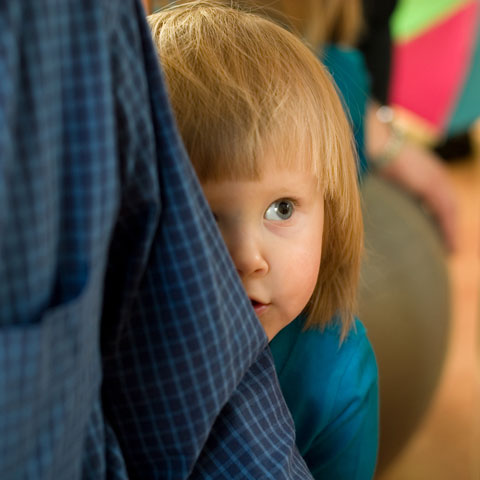Stress and Trauma in Young Children
This topical guide will introduce you to important books, videos, and information resources available from the EI Clearinghouse and other sources. Contact us via online form or by phone (1-877-275-3227) to request a resource listed below (or ask your local public librarian). Note that some videos may be viewed online, and journal titles will take you to the publisher’s homepage.
Table of Contents

EIC Resources
Books
Blending theory and research into a powerful narrative, this book offers effective strategies for facilitating attachment in children who have experienced serious trauma.
Also available as an audiobook on 12 CDs
This book draws on the latest knowledge and research on complex trauma in children, as well as the author’s expertise, in order to outline a trauma-sensitive approach to these children and their parents.
For survivors rather than professionals, this book explores the journey all trauma survivors make, offering practical information and healing stories that provide a way out for those who are suffering.
This book will help you meet the emotional needs of children who are experiencing trauma, and to enable them to form healthy attachments, both within their families and beyond.
This book offers clinicians, mental health workers, and other professionals working with children a comprehensive collection of evidence-based literature on the immediate and lasting effects of trauma on children and adolescents. The text covers a wide array of specific types of disasters as well as highly pertinent topics such as school shootings and terrorism.
Resilient Therapy is an innovative way of strengthening children with complex needs. This handbook offers accessible and fun exercises and activities. In addition, the latest research is broken down to help in applying it to everyday situations.
From family instability and poverty to maltreatment to rapid social and technological changes, children endure more stressors than ever before. A young child’s brain is uniquely sensitive to the effects of stress and trauma. This resource will help you find answers, ideas and specific classroom strategies to move children in positive directions. You will learn ways to help children build resilience, self-regulation, and self-competence.
This monograph provides leadership and guidance to the EI/ECSE field by creating a deeper understanding of maltreatment and illustrating evidence-based strategies to support these populations.
This book provides a new lens through which to understand safety and regulation. For therapists working with both adults and children and anyone dealing with symptoms that typically arise from early childhood trauma–anxiety, behavioral issues, depression, metabolic disorders, migraine, sleep problems, and more–this book offers fresh hope.
This book presents the principles of emotion-focused therapy which treats the symptoms of post-traumatic stress disorder, describing how a strategy of compassion and self-help techniques can be used to create a personal sense of security and well-being.
A pioneering physician reveals how childhood stress leads to lifelong health problems, and what people can do to break the cycle.
This book is the perfect starting point for any adult caring for or working with a child who has experienced trauma. It will help them to understand more about a child’s emotional and behavioral responses following trauma and provides welcome strategies to aid recovery.
A resource for parents, teachers, and anyone working with children. Written following two of the nation’s largest natural disasters, Hurricane Katrina and Rita, the book was written to help adults peer into the minds of children from infancy through the teenage years, and understand their confusion, fears, grief, and struggles to understand why the forces of nature can suddenly disrupt or destroy the world as they know it. It is to help both those who experience and survive catastrophe firsthand, as well as the children who witness from a distance and wonder what it was like or whether someday they will find themselves in similar circumstances.
Videos and Media
Based on developmentally best practices, research, Head Start Performance Standards, NAEYC standards, and the work of the Child Trauma Academy, this program gives teachers the skills to help their preschool and early elementary children get back to normal after a traumatic event, such as a natural disaster.
This Apples Video Magazine focuses on the role that teachers, parents and other adults play in helping children deal with death, divorce, illness, war, abuse/neglect, and domestic violence presenting resources that can be used in dealing with these issues, including appropriate children’s literature.
his video explains that the repeated stress of abuse, neglect and parents struggling with mental health or substance abuse issues has real, tangible effects on the development of the brain. This unfolds across a lifetime, to the point where those who’ve experienced high levels of trauma are at triple the risk for heart disease and lung cancer.
Illinois Newsroom spoke with a panel of Champaign County experts about how supportive relationships early in life can minimize long-term consequences of early childhood adversity and how breaking cycles of trauma requires the collective action of entire communities.
In this webinar, Dr. Sangeeta Parikshak, social science analyst at the Office of Head Start, is joined by experts in the field. They explore what trauma is and how to recognize its signs and symptoms in young children. They also discuss strategies to promote resilience in children and the adults who care for them.
Traumatic experiences in childhood have profound negative effects on health and well-being for life, including historical trauma experienced generations earlier. This video is part of the Whole People video series that spotlights the impact of Adverse Childhood Experiences (ACES) through personal and community stories.
Organizations
Promotes the safety, permanency, and well-being of children, youth, and families by connecting child welfare, adoption, and related professionals as well as the public to information, resources, and tools covering topics on child welfare, child abuse and neglect, out-of-home care, adoption, and more.
Articles
The article focuses on the need of caring children that have experienced natural disasters for helping them improve mental health. It states the Hurricane Katrina of 2005 that killed a number of people, and mentions that many children lost their families during the natural disaster. It offers suggestions for providing care to the children like afterschool program, and meeting the specific needs of the children like reliance on caregivers, and communication and identification of disability. Available upon request from the EI Clearinghouse.
Federal directives require that any child less than 3 years old with a substantiated case of abuse be referred to the early intervention (EI) system. This article details the need and presents a vision for a trauma-informed EI system. The authors describe two exemplary program models which implement this vision and recommend steps which the field can take to move toward a trauma-informed EI.
Web Resources
Child Welfare Information Gateway, 2018
This bulletin describes the intersection of child welfare and EI, provides an overview of the EI process, and outlines the challenges and strategies for implementing EI provisions in Federal law.
This resource offers information to help you understand how babies and toddlers can be affected by a natural disaster, such as a hurricane, and what you can do to help your child cope.
This factsheet discusses the nature of trauma, especially abuse or neglect, the effects of trauma on children and youth, and ways to help a child who has experienced trauma.
If you are parenting a child or youth with a history of abuse or neglect, you might have questions about the impacts and how you can help your child heal. This factsheet is intended to help parents (birth, foster, and adoptive) and other caregivers better understand the challenges of caring for a child or youth who has experienced maltreatment and learn about available resources for support.
Administration for Children & Families. US Department of Health and Human Services, 2015
The author briefly summarizes what is known about the impact of trauma on infants and, and the intervention strategies that could potentially protect them from the adverse consequences of traumatic experiences. She focuses on interventions that support parents in providing the stable and nurturing caregiving that is responsive to the child’s general developmental needs and that promotes children’s sense of safety and security.
Do you sometimes experience stress? So does your child. Stress may be a part of life for everyone, but prolonged stress can be harmful. You can help your child learn to recognize and cope with the feelings of frustration, sadness, worry, and anger that can lead to stress or be signs of stress. Also in Polish, Korean, Chinese, Arabic, and French.
Children with disabilities are at least three times more likely to be abused or neglected than their peers without disabilities, and they are more likely to be seriously injured or harmed by maltreatment. This bulletin describes the scope of the problem, risk factors, and strategies for prevention.
This issue brief provides basic information on brain development and the effects of abuse and neglect on that development. The information is designed to help professionals understand the emotional, mental, and behavioral impact of early abuse and neglect in children who come to the attention of the child welfare system.

